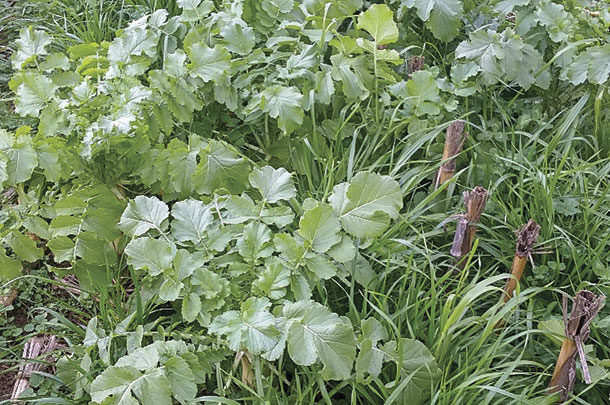Most of us live downstream from another farm, and water resources everywhere are a shared public good. Plus, after paying good money for fertilizer, you don’t want to see it leave with the next heavy rain. Nitrogen especially is expensive and easily leached out of the soil. The long-term improvement in soil health from robust cover cropping ensures more consistently high yields in both wet and dry years.
What are the dangers?
Nitrogen, phosphorus, sediment and pesticide losses are the big sources of agricultural runoff and source of lost input expenditure.
Phosphorus hasn’t been found to wash away in the same way as nitrogen but can bind to sediment and is lost along with it – so preventing erosion goes a long way to holding onto phosphorus. All could be greatly slowed by vegetation to mitigate leaching, runoff and erosion.
Sediment is agriculture’s number one pollutant, and any soil that isn’t covered is at risk for water erosion. Growing cover crops to maximize biomass greatly slows the movement of water across the soil surface. Consider: When water velocity across a surface is doubled (for example, by removing vegetation), the water’s carrying capacity for soil sediment geometrically increases by 26, or 64 times.
Nutrient loading from nitrogen and phosphorus is another huge problem, not only for the farmer who paid for the nutrients but the water bodies that receive them. They feed micro-organisms that take over in the water body, which then use up the oxygen which should be available to other organisms. This lack of oxygen is known as hypoxia.
How can cover crops help?
More cover crop mixes are being incentivized by state and federal programs precisely because they can help with nutrient management in various at-risk watersheds. Cover crops help retain nutrients and sediment at both the soil surface level (preventing runoff and erosion) and at the subsoil level (preventing leaching). Fields without cover crops are vulnerable to losing more than twice as much nitrogen as non-cover-cropped fields.
Cover crops primarily create a physical barrier against wind and water erosion. The vegetation protects soil aggregates from breakdown through raindrop impact and also slows down wind speeds at ground level. A cover crop can decrease erosion by 90 percent, reduce pesticide runoff by 50 percent or more and reduce sediment loading by 75 percent, according to Ohio State University.
By uptaking nutrients in danger of leaching, cover crops conserve a great deal of nitrogen and phosphorus. In many rotations – especially corn and other row crops – fall and spring are the most vulnerable times for nitrogen loss, with their lack of actively growing vegetation and the likelihood of fields getting more precipitation than the plants can use during these times.
In perennial pasture and hay fields, the constant presence of a living root leaves little vulnerable time, except if manure is winter-applied or when these fields are being renovated.
Late-planted cover crops have less time to grow, tiller and develop their root systems, so they will have less impact in the form of late-fall nutrient sequestration and more in the realm of reducing erosion.
Brassicas such as radish or turnip have deep taproots. They scavenge nutrients and water and alleviate soil compaction. Their leafy growth is also quite competitive with weeds.
Cereal grains are high-biomass producers, suppress weeds and have competitive root systems, and are also great for scavenging excess nitrogen, often in the range of 51 to 270 pounds per acre, which they can hold onto for the next crop. All grasses uptake nitrogen through the boot stage, after which point they use it to produce the seed or grain.
Non-legume cover crops are the most effective at reducing soil loss – commonly by 31 to 100 percent over no cover. Legumes are used to fix nitrogen and will not be effective nitrogen scavengers. All cover crops provide ground cover to protect against erosion, creating a physical barrier and slowing the velocity of surface runoff and preventing the loss of nutrients and sediment.
Using mixes heavy on legumes, such as clovers and vetches, is useful in rotation with corn or sorghum crops because they supply some nitrogen and reduce the need for nitrogen fertilizers in the field – reducing the chances of excess nutrients left to leach out of soil. These mixes provide a yield benefit to the corn or summer-annual grass.
Cover crops can potentially reduce pesticide use. They contribute to weed suppression physically and by secreting allelopathic chemicals. They can also reduce soil-borne pathogens such as SCN, since brassicas and other crops secrete nematicidal compounds, or simply behave as a non-host to the pest. (This is especially true of rye and ryegrass.)
Some green cover crops act as a trap crop, attracting invaders such as armyworm, cutworm and slugs. If a cover crop is allowed to grow and mature, especially to flowering, it can attract pollinators and beneficial insects that prey on harmful pests. All of these benefits can potentially reduce the need for chemicals.
Cover crops increase soil carbon/soil organic matter, which builds macroporosity, soil permeability, mean aggregate size and aggregate stability – factors that help it absorb and hold water and nutrients more effectively. It also reduces compaction, reducing the threat of surface runoff.
Increasing soil structure and stability also improves soil’s ability to hold up to machinery while reducing compaction, making the field more accessible.
With termination of cover crops, the nitrogen held in the plant tissue will slowly release as the following crop needs it. This release will be faster in wet years, however, since the microbes are more active. A small amount of nitrogen volatilization can occur in no-till systems, where the residue is left on the surface, but leaching of nitrates through the soil accounts for far more of the losses.
Increase cover, decrease tillage
The USDA-NRCS gets their message across well these days – get soil covered for as much of the year as possible and disturb it as little as possible. Reducing tillage (we don’t have to abandon it altogether) can greatly improve soil structure and cut down on nutrient losses.
Arbuscular mycorrhizal fungi live in symbiosis with a living plant root, acting as an extension of the root’s scavenging ability while subsisting on nourishment provided by the roots. Mycorrhizae do vastly better in undisturbed soil and with a living cover for a food source. Glomalin, produced by the hyphae and spores of the mycorrhizae, is a glue-like glycoprotein that promotes aggregate stability and improved soil structure.
With better soil structure comes better water infiltration, directing more of the flow to percolate down into soil so less of it can travel laterally over the surface and wash away applied nutrients. The improved biological, chemical and physical soil qualities built up by cover crops help make the soil both a more retentive and more permeable medium – accepting and holding on to more of the valuable stuff.
Many farmers choose to expand the potential of cover crops by interseeding them in corn at V4-V5. By expanding the cover crop growing season in this way, they give it the advantage of developing deeper roots and more possibility for nutrient retention, water infiltration and winter hardiness. Other best management practices to reduce nutrient losses include conservation tillage, vegetative filler strips and nutrient management planning.
Cover crops are a widespread necessity, as nutrients are easily lost with erosion, and quality in some major waterways has suffered for decades (it has improved in some, like the Chesapeake Bay) and, on the bright side, cover-cropped acreage rises by millions every year.
Cover crops protect and even improve water quality by building up soil with their root systems to hold onto potential pollutants. They increase infiltration and soil porosity and decrease compaction, which helps alleviate runoff and erosion into small streams and major waterways. Organic matter and root material absorb and filter out pollutants in runoff.
Even cover crops eventually used as forage can perform these important services throughout most of their life cycle and, after harvest, their root systems and any remaining residual continue anchoring and protecting soil until they are sprayed or plowed under. ![]()
PHOTO: Cover crops increase infiltration and soil porosity and decrease compaction, which helps alleviate runoff and erosion into small streams and major waterways. Photo by Genevieve Slocum.

-
Genevieve Slocum
- King’s AgriSeeds Inc.
- Email Genevieve Slocum











